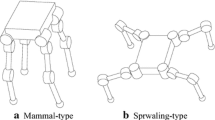Abstract
Motion coordination is a key factor affecting the stability and efficiency of robots. Such coordination involves the intra-limb coordination between each motion stage of a single leg and the inter-limbs coordination among all legs. The motion behaviors of animals, which have developed over a long period of evolution, offer good prototypes for the motion control of robots. In this paper, the locomotion of a quadruped sprawling animal (i.e., gecko) trotting on a horizontal surface was observed, and the feet trajectories around the hip on the same side were analyzed by statistical analysis and curve fitting. Results showed that feet on stance phase maintain the same speed to satisfy the requirement of inter-limb coordination. In swing phase, feet speed decreases from the moving speed to zero at the beginning and increases from zero to the desired speed in the next step at the end. The feet accomplish the transition from the backmost to the foremost position along a smooth curve that can be fit by a cosine function, which has good kinematic and dynamic characters. A foot trajectory planning method for robots was proposed based on the experiment results, which offered references not only for the foot trajectory planning of robots to realize intra-limb coordination but also for the inter-limbs coordination between stance feet during locomotion. Finally, the motion of a sprawling robot is simulated by using the bio-inspired trajectories to show the performance and benefits of the proposed method.
Similar content being viewed by others
References
F. J. Diedrich, F. J. Diedrich and W. H. Warren, Why change gaits? Dynamics of the walk-run transition, Journal of Experimental Psychology. Human Perception and Performance, 21 (1) (1995) 183–202.
G. J. Goslow, H. Seeherman, C. Taylor, M. Mccutchin and N. Heglund, Electrical activity and relative length changes of dog limb muscles as a function of speed and gait, Journal of Experimental Biology, 94 (1981) 15–42.
K. S. Espenschied, H. J. Chiel, R. D. Quinn and R. D. Beer, Leg coordination mechanisms in the stick insect applied to hexapod robot locomotion, Adaptive Behavior, 1 (4) (1993) 455–468.
J. T. Manter, The dynamics of quadrupedal walking, Journal of Experimental Biology, 15 (1938) 522–540.
S. Millera, J. V. D. Burga and F. G. A. V. D. Mechéa, Coordination of movements of the hindlimbs and forelimbs in different forms of locomotion in normal and decerebrate cats, Brain Research, 91 (2) (1975) 217–237.
V. Ja and P. Mc., Inter and intratrial variation in cat locomotor behavior, Physiology and Behavior, 33 (5) (1984) 733–43.
A. W. English, Interlimb coordination during stepping in the cat: an electromyographic analysis, Journal of Neurophysiology, 42 (1) (1979) 229–243.
M. Raibert, Symmetry in running, Science, 231 (4743) (1986) 1292–1294.
M. H. Raibert, Running with symmetry, International Journal of Robotics Research, 5 (3) (1986) 3–19.
M. Raibert, M. Chepponis and H. B. J. Brown, Running on four legs as though they were one, International Journal of Robotics and Automation, RA 2 (2) (1986) 70–82.
M. Won, T. Kang and W. K. Chung, Dynamical balancing control for stable walking of quadruped robot, 5th International Conference on Ubiquitous Robots and Ambient Intelligence, Seoul, South Korea (2008) 769–773.
M. Buehler, R. Playter and M. Raibert, Robots step outside, Internal Symposium on Adaptive Motion of Animals and Machines, Ilmenau, Germany (2005) 1–4.
M. Raibert, K. Blankespoor, G. Nelson, R. Playter and T. B. Team, BigDog, the rough-terrain quadruped robot, Proceedings of the 17th World Congress the International Federation of Automatic Control, Seoul, Korea (2008) 10822–10825.
S. Zhang, X. Rong, Y. Li and B. Li, A free gait generation method for quadruped robots over rough terrains containing forbidden areas, Journal of Mechanical Science and Technology, 29 (9) (2015) 3983–3993.
T. Kano, D. Owaki and A. Ishiguro, Reconsidering inter-and intra-limb coordination mechanisms in quadruped locomotion, IEEE/RSJ International Conference on Intelligent Robots and Systems, Vilamoura, Algarve, Portugal (2012) 4873–4878.
A. J. Ijspeert, Central pattern generators for locomotion control in animals and robots: A review, Neural Networks, 21 (2008) 642–653.
H. R. Wilson and J. D. Cowan, Excitatory and inhibitory interactions in localized populations of model neurons, Biophysical Journal, 12 (1972) 1–24.
A. J. Ijspeert, A. Crespi, D. Ryczko and J.-M. Cabelguen, From swimming to walking with a salamander robot driven by a spinal cord model, Science, 315 (5817) (2007) 1416–1420.
K. Osaku, H. Minakata and S. Tadakuma, A study of CPG based walking utilizing swing of arms, The 9th International Workshop on Advanced Motion Control, Istanbul, Turkey (2006) 392–396.
H. Li, Z. Dai, A. Shi, H. Zhang and J. Sun, Angular observation of joints of Geckos moving on horizontal and vertical surfaces, Chinese Science Bulletin, 54 (4) (2009) 592–598.
K. Kim and J. Park, Ellipse-based leg-trajectory generation for galloping quadruped robots, Journal of Mechanical Science and Technology, 22 (11) (2008) 2099–2106.
Author information
Authors and Affiliations
Corresponding author
Additional information
Recommended by Associate Editor Kyoungchul Kong
Hongkai Li received his M.S. and Ph.D. from Nanjing University of Aeronautics and Astronautics, Nanjing, China, in 2006 and 2010, respectively. Currently, he is working for Institute of Bioinspired Structure and Surface Engineering in this university as an Assistant Professor. His research interests include motion control of bionic robots and intelligent robotics.
Rights and permissions
About this article
Cite this article
Li, H., Shi, A. & Dai, Z. A trajectory planning method for sprawling robot inspired by a trotting animal. J Mech Sci Technol 31, 327–334 (2017). https://doi.org/10.1007/s12206-016-1235-x
Received:
Revised:
Accepted:
Published:
Issue Date:
DOI: https://doi.org/10.1007/s12206-016-1235-x




